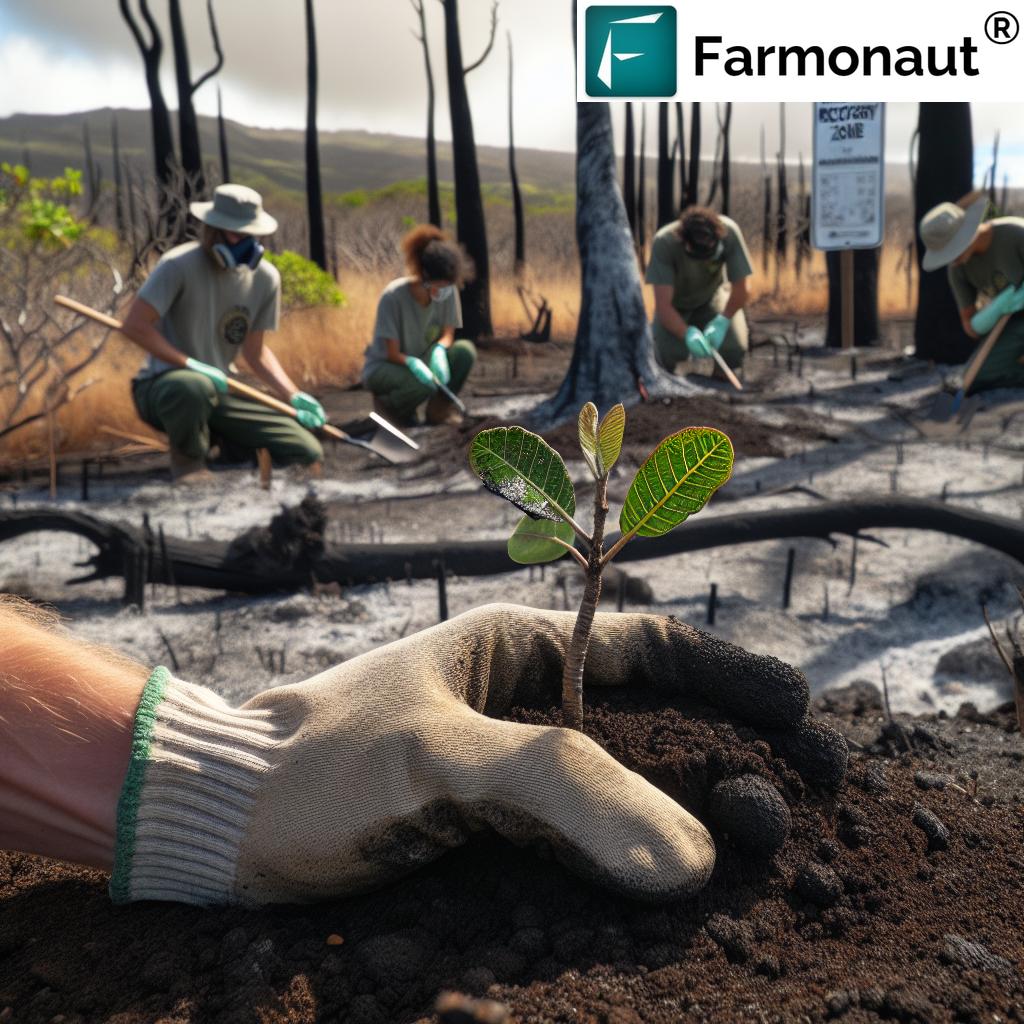Maui Wildfire Recovery: Navigating Environmental Challenges and Legal Rulings in Hawaii’s Rebuilding Efforts
“The 2023 Maui wildfire led to a landmark Hawaii Supreme Court ruling affecting insurance lawsuits for over 3,000 victims.”
In August 2023, the island of Maui experienced one of the most devastating wildfires in recent U.S. history. As we approach the two-year mark since this tragic event, we find ourselves reflecting on the profound impact it has had on the community, the environment, and the legal landscape of Hawaii. In this comprehensive exploration, we’ll delve into the ongoing recovery efforts, the challenges faced by residents and officials, and the legal developments that continue to shape Maui’s path forward.
The Devastating Impact of the 2023 Maui Wildfire
The wildfires that swept through Lahaina and other parts of Maui in 2023 left an indelible mark on the island’s landscape and its people. With a death toll of 102 lives lost, thousands of homes destroyed, and historic structures reduced to ash, the Maui wildfire stands as the deadliest in the United States in over a century. The town of Lahaina, with its rich cultural heritage dating back to the days of the Hawaiian monarchy, bore the brunt of the destruction.
As we navigate the complex aftermath of this tragedy, it’s crucial to understand the multifaceted nature of the recovery process. From environmental concerns to legal battles and community resilience, the road to rebuilding Maui is paved with both challenges and hope.

Legal Landscape: Hawaii Supreme Court’s Landmark Ruling
In February 2025, the Hawaii Supreme Court made a pivotal decision that has significantly impacted the course of legal proceedings related to the Maui wildfire. The court ruled that insurance companies cannot file separate lawsuits against defendants blamed for the disaster. This ruling has cleared the way for a proposed $4 billion settlement to victims who had filed lawsuits, primarily against Hawaiian Electric Company.
The implications of this decision are far-reaching:
- It prevents a potential flood of individual lawsuits from insurance companies seeking to recover costs paid to policyholders.
- The ruling applies state laws limiting healthcare insurance reimbursement to property and casualty insurance, effectively minimizing insurers’ independent legal avenues.
- Attorneys representing the plaintiffs have expressed satisfaction with the outcome, as it allows the settlement process to move forward more efficiently.
This legal development underscores the complexity of disaster recovery and the need for a balanced approach that considers the interests of victims, insurers, and the broader community.
Environmental Challenges in the Wake of the Wildfire
“Lahaina’s rebuilding efforts face challenges with removing an estimated 400,000 tons of wildfire debris.”
As Maui works towards recovery, one of the most pressing environmental concerns is the management and disposal of debris left in the wake of the wildfire. The scale of this challenge is immense, with an estimated 400,000 tons of debris requiring removal and proper disposal.
Temporary Dump Site Concerns
The establishment of a temporary dump site for wildfire debris has raised significant environmental concerns among residents and experts alike. Key issues include:
- The potential for contaminated soil to leach into the surrounding environment
- Fears of pollution spreading into the ocean, potentially impacting marine ecosystems
- The need for rigorous environmental monitoring and safeguards to protect public health
Maui officials are working diligently to secure land for a permanent debris site, but this process has been complicated by legal challenges and negotiations with private landowners. The urgency of debris removal must be balanced with long-term environmental stewardship to ensure the health and safety of Maui’s residents and ecosystems.
Ecological Impact and Restoration Efforts
Beyond debris management, the wildfire has had a profound impact on Maui’s ecology. The loss of vegetation has increased the risk of soil erosion, potentially affecting water quality and marine habitats. As we work towards recovery, there’s a growing focus on:
- Reforestation initiatives to restore native plant species
- Soil stabilization projects to prevent erosion and protect watersheds
- Monitoring and protection of endangered species whose habitats may have been affected
These environmental challenges underscore the need for a holistic approach to recovery that considers both immediate needs and long-term sustainability.
Rebuilding Lahaina: Progress and Challenges
The process of rebuilding Lahaina has begun, marking a significant milestone in Maui’s recovery journey. As of early 2025, we’ve seen encouraging signs of progress:
- Residential permits have been issued for rebuilding homes
- Construction has commenced on several properties
- The iconic banyan tree, a symbol of Lahaina’s resilience, has shown signs of regrowth
However, the path to full recovery remains complex and fraught with challenges. The community grapples with a range of emotions as they balance the desire to rebuild with the need to preserve their cultural heritage.

Community Sentiments and Cultural Preservation
The rebuilding process has evoked mixed emotions within the Lahaina community. While there’s a strong desire to restore homes and businesses, many residents emphasize the importance of preserving the town’s rich cultural heritage. Key considerations include:
- Incorporating traditional Hawaiian architectural elements in new construction
- Preserving historical sites and landmarks that survived the fire
- Creating memorials to honor those lost in the tragedy
As we move forward, it’s crucial to strike a balance between modernization and cultural preservation, ensuring that the rebuilt Lahaina retains its unique character and historical significance.
Housing Affordability and Land Speculation Concerns
One of the most pressing issues facing Maui in the wake of the wildfire is housing affordability. The destruction of thousands of homes has exacerbated an already challenging housing market. Concerns include:
- The potential for land speculation driving up property prices
- Displacement of long-time residents unable to afford rebuilding or increased costs
- The need for affordable housing solutions to maintain Lahaina’s diverse community
To address these concerns, county officials have pledged to institute moratoriums on land transactions in Lahaina. This measure aims to protect local residents from opportunistic buyers and preserve the community’s character.
Investigating the Causes: Scrutiny of Emergency Management and Utilities
As recovery efforts continue, investigations into the causes of the Maui wildfire have led to intense scrutiny of emergency management practices and utility companies. Key areas of focus include:
Emergency Response and Warning Systems
The chaotic evacuation during the wildfire has raised critical questions about the effectiveness of emergency management systems. Concerns include:
- Failure to activate warning sirens, which were meant to alert residents to the approaching fire
- Breakdown in communication systems, leaving many residents without crucial information
- Inadequate evacuation plans and routes, leading to traffic congestion and trapped residents
These failures have prompted a comprehensive review of emergency protocols and the implementation of more robust warning systems to prevent similar tragedies in the future.
Utility Company Accountability
The Hawaiian Electric Company has faced significant scrutiny in the aftermath of the wildfire. Allegations include:
- Power lines potentially igniting dry vegetation, sparking the initial blaze
- Questions about the company’s maintenance practices and fire prevention measures
- Debates over the timing of power line de-energization during high-risk conditions
While the company has disputed accusations of negligence, ongoing investigations continue to examine the role of utility infrastructure in the wildfire’s outbreak and spread.
Legal Battles and Settlements
The legal landscape surrounding the Maui wildfire continues to evolve, with numerous lawsuits filed against various entities. Key developments include:
- A proposed $4 billion settlement for victims who filed lawsuits against Hawaiian Electric Company
- Lawsuits against telecommunication companies for alleged failures in providing timely alerts
- Ongoing investigations to determine liability and accountability for the disaster
These legal proceedings play a crucial role in providing compensation to victims and holding responsible parties accountable. However, they also highlight the complex interplay of factors that contributed to the tragedy.
Community Resilience and Mental Health Support
As Maui navigates the challenging path to recovery, the resilience of its community has been a beacon of hope. However, the emotional and psychological toll of the disaster cannot be understated. Efforts to support mental health and community well-being include:
- Deployment of counseling and mental health services for affected residents
- Community support groups and healing circles to foster connection and shared healing
- Programs to preserve and celebrate Lahaina’s cultural heritage as part of the recovery process
These initiatives underscore the importance of addressing not only the physical reconstruction of Lahaina but also the emotional and cultural fabric of the community.
Wildfire Prevention Strategies for the Future
The Maui wildfire has sparked intense discussions about wildfire prevention strategies across Hawaii and beyond. Key areas of focus include:
- Improved vegetation management and creation of firebreaks in high-risk areas
- Enhanced early warning systems and evacuation protocols
- Stricter building codes to promote fire-resistant construction
- Investment in advanced firefighting technologies and resources
These strategies aim to reduce the risk of future wildfires and enhance community preparedness in the face of increasing climate-related hazards.
The Role of Technology in Disaster Management and Recovery
As we look to the future of disaster management and recovery, technology plays an increasingly crucial role. Advanced solutions, such as those offered by Farmonaut, can contribute significantly to environmental monitoring, resource management, and sustainable rebuilding efforts.
Farmonaut’s satellite-based crop health monitoring and AI-driven advisory systems can be invaluable in assessing and managing vegetation health in fire-prone areas. By providing real-time data on vegetation density and moisture levels, such technologies can help identify high-risk zones and inform targeted prevention strategies.
Furthermore, Farmonaut’s blockchain-based traceability solutions could potentially be adapted to track the movement and disposal of wildfire debris, ensuring transparency and accountability in the recovery process.
For developers interested in integrating these advanced technologies into their own disaster management solutions, Farmonaut offers API access to its satellite and weather data. You can explore the API documentation for more information.
Maui Wildfire Recovery Timeline
| Date | Event | Impact |
|---|---|---|
| August 8, 2023 | Maui wildfire outbreak | 102 lives lost, thousands of homes destroyed, historic Lahaina town devastated |
| September 2023 | Debris removal efforts begin | Environmental concerns raised about temporary dump sites |
| December 2023 | First residential rebuilding permits issued | Marks the beginning of Lahaina’s reconstruction |
| February 2025 | Hawaii Supreme Court ruling on insurance lawsuits | Clears way for proposed $4 billion settlement to victims |
| Ongoing | Investigations into wildfire causes | Scrutiny of utility companies and emergency management practices |
Conclusion: A Path Forward for Maui
As we reflect on the journey of recovery following the 2023 Maui wildfire, it’s clear that the path forward is both challenging and filled with opportunities for positive change. The resilience of the Lahaina community, coupled with innovative approaches to rebuilding and disaster prevention, offers hope for a more sustainable and fire-resistant future.
Key takeaways from this exploration include:
- The importance of balancing rapid recovery with thoughtful, sustainable rebuilding
- The need for improved emergency management systems and wildfire prevention strategies
- The crucial role of community involvement in shaping the recovery process
- The potential for technology to enhance disaster preparedness and response
As Maui continues to navigate the complex landscape of recovery, the lessons learned from this tragedy will undoubtedly inform disaster management practices not only in Hawaii but across the globe. The spirit of aloha and the strength of the Maui community remain powerful forces driving the island’s rebirth and renewal.
FAQs
- Q: How long is the recovery process expected to take?
A: The recovery process is ongoing and expected to take several years. While initial rebuilding efforts have begun, full recovery, including environmental restoration and community healing, may extend well into the future. - Q: What measures are being taken to prevent future wildfires in Maui?
A: Measures include improved vegetation management, enhanced early warning systems, stricter building codes for fire resistance, and investment in advanced firefighting technologies. - Q: How can individuals contribute to Maui’s recovery efforts?
A: Individuals can contribute through donations to reputable relief organizations, supporting local Maui businesses, and participating in volunteer programs focused on rebuilding and environmental restoration. - Q: What legal recourse do victims of the Maui wildfire have?
A: Victims have been able to participate in lawsuits against entities deemed responsible for the disaster. A proposed $4 billion settlement is currently in progress for those who filed suits against Hawaiian Electric Company. - Q: How is the mental health of Maui residents being addressed in the recovery process?
A: Mental health support includes counseling services, community support groups, and programs designed to preserve and celebrate Lahaina’s cultural heritage as part of the healing process.
Earn With Farmonaut: Affiliate Program
Earn 20% recurring commission with Farmonaut’s affiliate program by sharing your promo code and helping farmers save 10%. Onboard 10 Elite farmers monthly to earn a minimum of $148,000 annually—start now and grow your income!
















